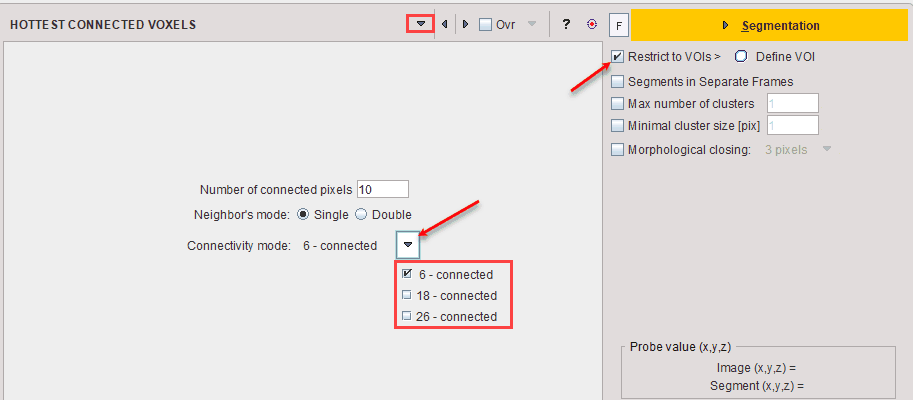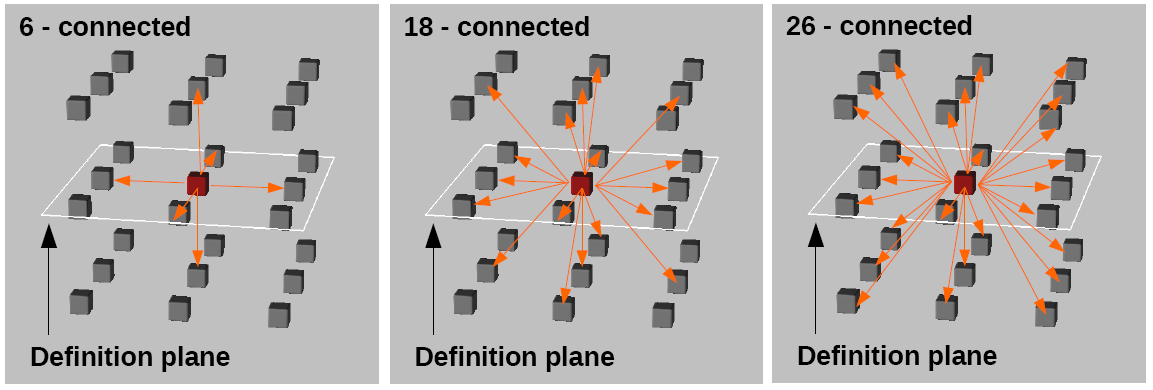The Hottest Connected Pixels (HCP) is a segmentation method used to objectively outlined brain anatomical structure like the locus coeruleus/subcoeruleus complex in T1 weighted MRI images [2]. Another potential application is the extraction of the image derive input function.
It is recommended to use a VOI as boundary restrictions for the algorithm as illustrated below:

The HCP method aims at identifying a well-defined number of connected pixels whose average value is maximal. The pixel connectivity is representing the way in which pixels in 2-dimensional (or voxels in 3-dimensional) images relate to their neighbors [1].
The actual Number of connected pixels can be specified in the interface.
Initially, the average value of the activity in the whole VOI is calculated. The searching process of the neighbors, using either the Single or the Double mode, is repeated for each pixel with value greater than the average value in the parent VOI. The selected Connectivity mode is used to find the neighbors of the current pixel in the searching process.
With the Single mode enabled and based on the selected connectivity model, the algorithm is searching around the current voxel the voxel with the highest value to add it as part of the segment. Next, the voxel with the highest value is searched around the new segment. The operation is repeated until the pre-defined number of connected pixels is detected.
With the Double mode enabled and based on the selected connectivity model, the algorithm is searching around the current voxel the voxel which has the highest summed value with his next neighbor. When the highest summed value is identified the algorithm is adding to the segment the voxel and its next neighbor in one step. If the tested voxel has no neighbor, his value is considered by the algorithm. Note that once a voxel is added to the segment, its value is not considered anymore as the next neighbor. The process is repeated until the pre-defined number of connected pixels is detected.
The segment which average value is maximal will generate the 3D binary segment.
The tool implements three models of connectivity as illustrated below:

The 6-connected pixels are neighbors to every pixel that touches one of their faces (cross connection). These pixels are connected along one of the primary axes [1].
The 18-connected pixels are neighbors to every pixel that touches one of their faces (cross connection) or edges (oblique connection). These pixels are connected along either one or two of the primary axes[1].
The 26-connected pixels are neighbors to every pixel that touches one of their faces (cross connection), edges (oblique connection), or corners. These pixels are connected along either one, two, or all three of the primary axes [1].
References
1.https://en.wikipedia.org/wiki/Pixel_connectivity
2.Lorenzo DG, Longo-Dos Santos C., Ewenczyk C., Leu-Semenescu S., Gallea C., Quattrocchi G.,Pita Lobo P., Poupon C.,Benali H., Arnulf I., Vidailhet M., Lehericy S.: The coeruleus/subcoeruleus complex in rapid eye movement sleep behaviour disorders in Parkinson’s disease. Brain 2013, 136:2120–2129. DOI.